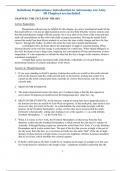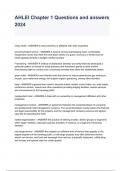Solutions Explorations: Introduction to Astronomy 10e Arny
All Chapters are included
CHAPTER 1 THE CYCLES OF THE SKY
Lecture Suggestions
Planetarium software may be helpful for this chapter. An orrery (mechanical model of the
Sun and Earth) or even just an approximation of one can also help illustrate various motions and
that the constellations change with the seasons. Set it on a table in the front of the room and then
mark off constellations on the walls with chalk or paper decorations. Moving the model Earth
around the model Sun then allows students to see how the stars visibly change and how the Sun
“moves” through the Zodiac. In effect, this turns the room into a simple planetarium.
A flashlight with a fat beam shows the importance of angle to seasonal heating. When
directed directly at the wall the energy is concentrated in a small area. When shined obliquely at
the wall, the beam covers a larger area, implying less concentration of heat and therefore a lower
temperature. It’s also important to include the idea that the day is longer in the summer, which is
sometimes overlooked.
A bright light source and tennis balls, basketballs, volleyballs or even golf balls can
demonstrate features of eclipses and phases of the moon.
Answers to Thought Questions
1. If you were standing on Earth’s equator, looking due north you would see the north celestial
pole on the horizon (and the south celestial pole on the horizon, looking due south).You
cannot see the north celestial pole from Australia (it’s below the horizon), only the south
celestial pole.
2. SKETCH FOR STUDENTS
3. The main astronomical reason why there are 12 zodiacal signs is that the Sun appears to
move about 30 degrees per month across the background stars ( = 12).
4. SKETCH FOR STUDENTS. At the horizon, setting or rising stars move perpendicularly to
the horizon (so they are useful for East-West navigation). At the north pole, stars more or less
do not set, they just circle in the sky. At a mid-latitude, the stars make an angle with the
horizon. In the Northern Hemisphere, as they set they also move more toward the north.
Extremely schematically: setting stars looking west: at the equator, | | |; at a mid-latitude,
Northern Hemisphere: \ \ \; at the North Pole, ---.
5. When it is winter in New York, the Northern Hemisphere is tilted away from the Sun;
therefore at that time the Southern Hemisphere is tilted towards the Sun and it’s summer in
Australia. Although Beijing is partway around the world from New York, it’s in the Northern
Hemisphere and it is also winter there. The part of the sky that you see at night is the part of
the sky away from the Sun, so everywhere on Earth sees the same “half” of the sky at night
during a 24 hour period, as Earth rotates viewers into nighttime: all three locations should be
able to see Orion, which straddles the celestial equator.
6. If Earth’s orbit had no tilt, there would be no variation in the angle of sunlight over the year,
nor would there be variation in the length of day—conditions would be somewhat like the
1
, Chapter 1 The Cycles of the Sky
equinox all the time and a 12 hour day everywhere, every day. There would be a slight
variation in temperature over the year with higher temperatures in January based on the small
change in Earth’s distance from the Sun, but this effect would be very small (clearly it does
not affect the seasons induced by the tilt very much). Northern and Southern hemispheres
would experience these weak seasons at the same time.
7. The position of sunrise along the eastern horizon changes during the year because Earth’s
axis (and correspondingly, the celestial equator) is tilted at 23.5 degrees to the plane of its
orbit (the ecliptic) and Earth maintains this same tilt throughout the year. At the equinoxes
(March 21 and Sept. 23), the Sun lies on the celestial equator. Because the celestial equator
cuts the horizon at the east and west points, the Sun will rise and set due east and due west,
respectively. In winter, the tilt of Earth results in the Sun rising north of east and setting north
of west, and in winter, the Sun rising south of east and setting south of west. At the winter
solstice (Dec. 21), the Sun lies 23.5 degrees south of the celestial equator on the sky. It will
therefore rise the most to the south of the East on the horizon and set the most to the south of
West that year. At the summer solstice (June 21), the Sun lies 23.5 degrees north of the
celestial equator. It will therefore rise the most north of East and set the most North of West.
8. We have time zones to keep our local time in approximate alignment with solar time, and to
standardize time between different parts of countries and the world—using exact local solar
time everywhere would be just as confusing as using one set of hours for the whole world.
The sketch can show how it’s solar noon on one part of earth (the Sun is highest in the sky)
and a very different time elsewhere (the Sun would be high or low in the sky), or just show a
close-up of the difference between the local time in one time zone (say noon) and an adjacent
time zone (say 1 pm).
9. Some possible ideas: (One or two of these or related ideas should be sufficient).
– You can see some phases during the day, so the geometry is incorrect for the phase to be
a shadow.
– You can determine the Sun-Earth-Moon angle is not 180 degrees during most phases.
– Lunar eclipses (shadow on the Moon) do occur, and only during the 180 degree/full
moon alignment.
– The curvature of the terminator during Moon phases is not consistent from phase to
phase—if it was Earth’s shadow, it would always be the same shape. The changing
terminator shape is consistent with a partially illuminated sphere.
– The radius of curvature of the terminator for phases does not match the radius of the
shadow of Earth during an eclipse.
– Eclipses happen over a period of hours, while the phases change slowly over weeks,
suggesting they are not caused by the same thing.
10. In this case, the sidereal month would remain 27.3 days as the periodic alignment with the
stars would not change, but the solar month would be shorter because the Moon will reach
new moon before re-aligning with the stars instead of after. The redrawn figure of 1.14
should indicate this is the case (the right part of the diagram will happen in opposite order).
2





